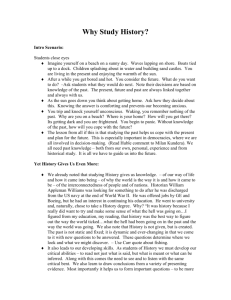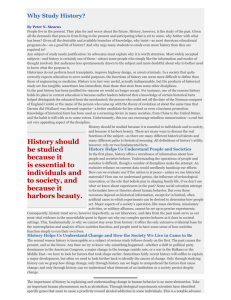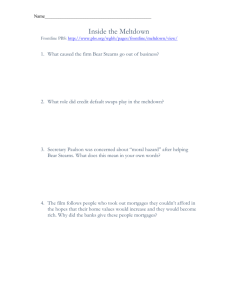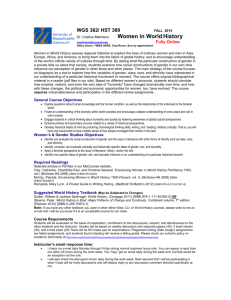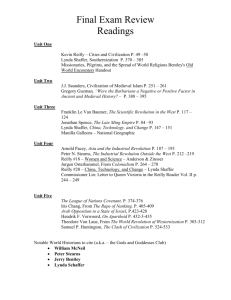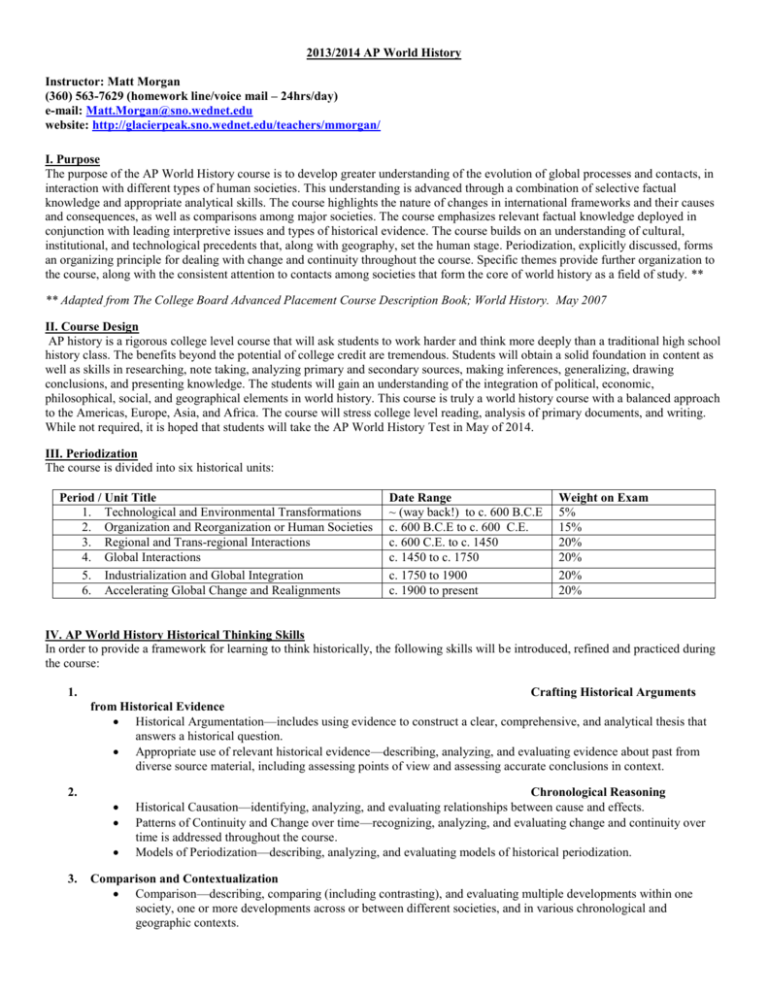
2013/2014 AP World History
Instructor: Matt Morgan
(360) 563-7629 (homework line/voice mail – 24hrs/day)
e-mail: Matt.Morgan@sno.wednet.edu
website: http://glacierpeak.sno.wednet.edu/teachers/mmorgan/
I. Purpose
The purpose of the AP World History course is to develop greater understanding of the evolution of global processes and contacts, in
interaction with different types of human societies. This understanding is advanced through a combination of selective factual
knowledge and appropriate analytical skills. The course highlights the nature of changes in international frameworks and their causes
and consequences, as well as comparisons among major societies. The course emphasizes relevant factual knowledge deployed in
conjunction with leading interpretive issues and types of historical evidence. The course builds on an understanding of cultural,
institutional, and technological precedents that, along with geography, set the human stage. Periodization, explicitly discussed, forms
an organizing principle for dealing with change and continuity throughout the course. Specific themes provide further organization to
the course, along with the consistent attention to contacts among societies that form the core of world history as a field of study. **
** Adapted from The College Board Advanced Placement Course Description Book; World History. May 2007
II. Course Design
AP history is a rigorous college level course that will ask students to work harder and think more deeply than a traditional high school
history class. The benefits beyond the potential of college credit are tremendous. Students will obtain a solid foundation in content as
well as skills in researching, note taking, analyzing primary and secondary sources, making inferences, generalizing, drawing
conclusions, and presenting knowledge. The students will gain an understanding of the integration of political, economic,
philosophical, social, and geographical elements in world history. This course is truly a world history course with a balanced approach
to the Americas, Europe, Asia, and Africa. The course will stress college level reading, analysis of primary documents, and writing.
While not required, it is hoped that students will take the AP World History Test in May of 2014.
III. Periodization
The course is divided into six historical units:
Period / Unit Title
1. Technological and Environmental Transformations
2. Organization and Reorganization or Human Societies
3. Regional and Trans-regional Interactions
4. Global Interactions
5. Industrialization and Global Integration
6. Accelerating Global Change and Realignments
Date Range
~ (way back!) to c. 600 B.C.E
c. 600 B.C.E to c. 600 C.E.
c. 600 C.E. to c. 1450
c. 1450 to c. 1750
c. 1750 to 1900
c. 1900 to present
Weight on Exam
5%
15%
20%
20%
20%
20%
IV. AP World History Historical Thinking Skills
In order to provide a framework for learning to think historically, the following skills will be introduced, refined and practiced during
the course:
1.
2.
Crafting Historical Arguments
from Historical Evidence
Historical Argumentation—includes using evidence to construct a clear, comprehensive, and analytical thesis that
answers a historical question.
Appropriate use of relevant historical evidence—describing, analyzing, and evaluating evidence about past from
diverse source material, including assessing points of view and assessing accurate conclusions in context.
3.
Chronological Reasoning
Historical Causation—identifying, analyzing, and evaluating relationships between cause and effects.
Patterns of Continuity and Change over time—recognizing, analyzing, and evaluating change and continuity over
time is addressed throughout the course.
Models of Periodization—describing, analyzing, and evaluating models of historical periodization.
Comparison and Contextualization
Comparison—describing, comparing (including contrasting), and evaluating multiple developments within one
society, one or more developments across or between different societies, and in various chronological and
geographic contexts.
4.
Contextualization - connect historical developments to specific circumstances of time and place and to broader
regional, national or global processes.
Historical Interpretation and Synthesis
Interpretation—describing, analyzing and evaluating diverse interpretations of past (primary and secondary sources)
Synthesis—constructing plausible arguments and narratives by drawing upon a wide array of source materials, as
well as historical and contemporary contexts.
V. Course Themes: The Five AP World History Themes
The AP World History course requires students to engage with the dynamics of continuity and change across the historical periods
that are included in the course. Students will be taught to analyze the processes and causes involved in these continuities and changes.
In order to do so, we will focus on five overarching themes which serve throughout the course as unifying threads, helping students to
put what is particular about each period or society into a larger framework. The themes also provide ways to make comparisons over
time and facilitate cross-period questions. Each theme will receive approximately equal attention over the course of the year.
1. Interaction between humans and the environment including:
• Demography and disease
• Migration
• Patterns of settlement
• Technology
2. Development and interaction of cultures including:
• Religions
• Belief systems, philosophies, and ideologies
• Science and technology
• The arts and architecture
3. State-building, expansion, and conflict including:
• Political structures and forms of governance
• Empires
• Nations and nationalism
• Revolts and revolution
• Regional, transregional, and global structures and organizations
4. Creation, expansion, and interaction of economic systems including:
• Agricultural and pastoral production
• Trade and commerce
• Labor Systems
• Industrialization
• Capitalism and socialism
5. Development and transformation of social structures including:
• Gender roles and relations
• Family and kinship
• Racial and ethnic constructions
• Social and economic classes
VI. The AP EXAM – Thursday, May 15, 2014 (That gives us about 36 school weeks to cover the 36 chapters in the book.)
The AP World History Exam has two main parts: the multiple-choice questions and the free-response questions. Students must answer
the 70 multiple-choice questions first, and then they have a 10-minute break before they begin the free-response section. At the
beginning of the second half of the exam, the proctor imposes a 10-minute reading and preparation period during which students are
restricted to reading and making notes in their green exam insert that contains the free-response questions. After the reading period,
students may begin writing their three essays in the pink free-response booklets. The first free-response question is the documentbased question (DBQ). The continuity and change-over-time question (CCOT) and the comparative question follow the DBQ. The
exam lasts three hours and five minutes. Fifty-five minutes are allocated for the multiple-choice section and 130 minutes total for
the free-response segment.
This is a challenging exam for most students who have yet to experience a college-level assessment.
A primary focus of each unit will be the introduction and reinforcement of the skills appropriate for student success in each of the
three essay categories found on the AP Test (DBQ, CCOT and Comparative).
VII. Materials and Resources
1.
Primary Textbook: World Civilizations: The Global Experience, by Peter Stearns, et. al.
TEXTBOOK WEBSITE: http://www.ablongman.com/stearns. Includes primary sources, practice tests, web links,
internet exercises, glossary and pronunciation guide for textbook.
2.
Supplementary Textbooks will be used for depth, as well as to compare coverage and viewpoint of different historical
events and eras.
The Earth and its Peoples by Bulliet, et. al. (Wadsworth, AP 5th ed., 2011)
Ways of the World by Strayer (Bedford / St. Martin’s, 2011)
Traditions and Encounters by Bentley and Ziegler (McGraw-Hill, 4th ed., 2008
The World’s History by Spodek (Prentice-Hall, 4th Ed., 2011)
Societies, Networks, and Transitions by Lockard (Wadsworth, 2nd ed., 2011)
3.
Supplementary Readers will be used throughout the course to provide primary source resource material to accompany
each unit.
4.
Worlds of History by Reilly (Bedford / St. Martin’s, 3rd ed., 2009)
The Human Record (vol.s one and two) by Andrea and Overfield (Wadsworth, 6th ed., 2009)
Discovering the Global Past (vol.s one and two) by Wiesner, et. al. (Houghton-Mifflin, 3rd ed., 2007)
Sources of Civilization (vol.s one and two) by Johnson (Prentice-Hall, 2nd ed., 2000)
Documents in World History (vol.s one and two) Pearson Prentice-Hall, 2005)
Sources provided by Prentice-Hall for the primary textbook at myhistorylab.com
Other Resources:
AP World History Test Prep Series by Marquez, et. al (Pearson Ed. Inc., 2007)
Fast Track to a 5: Preparing for the AP World History Examination by Brun-Ozuna, et. al., Wadsworth, 2011)
COLLEGE BOARD WEBSITE: http://www.collegeboard.com/ap/students/index.html. This Internet site
contains information about the World History AP Exam and how to prepare for it.
VIII. Course Notebook:
During the course of the year you will be introduced to, and responsible for, vast amounts of material. You need to be organized and
diligent. Thus, it is important to have an updated, organized, notebook.
How you organize it is up to you, but you may want to have nine dividers:
#1 – Rules, Housekeeping, Nuts-and-Bolts, etc.
#2 – DBQ Essay Information
#3 – CCOT Essay Information
#4 – Comp Essay Information
#5 – Periods One and Two
#6 – Period Three
#7 – Period Four
#8 – Period Five
#9 – Period Six
At the beginning of each of the above units, you should have a table of contents organized in chronological order.
IX. Grading Policy: Categories and their Weights
Tests (unit and mid-unit) and Quizzes (homework quizzes): 40%
In Class Work, Projects and Essays: 30%
a. Homework and other quizzes will be both announced and unannounced.
b. GPHS Social Studies Department Policy: Unexcused late work will not be accepted for credit.
Participation and Citizenship: 20%
a. Being prepared, on task and appropriate. Is responsible and makes a positive contribution to class either
verbally or by demonstrating a positive work ethic and appropriate classroom behavior.
b. Attitudes and behaviors elevate the classroom atmosphere to facilitate a positive learning climate.
Semester Exam (including a year-end comprehensive test): 10%
X. Scoring
100 - 93% = A
92 - 90% = A89 - 87% = B+
86 - 83% = B
82 - 80% = B79 - 77% = C+
76 – 73% = C
72 – 70% = C69 – 67% = D+
66 - 60% = D
Below 60% = F
XII. Student Responsibilities and Classroom Rules and Procedures – Condensed: Respect the school, your teacher, your
classmates, and yourself. Don’t impede the learning process for anyone, including yourself. Allow the teacher to teach and the
students to learn. If you need more detail, read on for specifics.
FOLLOW INSTRUCTIONS (the first time they are given). This includes those given by administrators, staff, substitute
teachers, and me.
COME TO CLASS PREPARED WITH ALL REQUIRED MATERIALS. Always assume that you need pen, pencil,
paper, and notebook.
TURN IN YOUR ASSIGNMENTS ON TIME. It is your responsibility to keep up with your work. Late work is not
accepted for credit (per department policy). Homework info available on classroom white board, my homework hotline, and
on my website. “I did not know we had homework” is not a valid utterance.
PROMPTNESS: Be in your seat before the bell rings. Books and notebooks need to be ready and you need to start your
warm up activities. Your third tardy will garner you a warning, the fourth a lunch detention, and the fifth an administrative
referral.
ATTENDANCE: Please avoid absences if possible. Absenteeism can quickly become a serious problem and inadvertently
impact your grade. Make-up work is done outside of class.
LECTURE/DISCUSSIONS: During lectures you are expected to quietly and attentively listen and take notes. At any time,
however, you are encouraged to ask questions or offer constructive comments. I will periodically ask questions during
lectures so be ready.
QUIET WORK / READING / WARM UPS: You will regularly be given time to work by yourself, quietly. The operative
words here are quiet and work.
WORKING UNTIL THE BELL: Everyone is expected to work up to the bell unless given permission by the teacher to
begin packing up early. Most days you will have a couple of minutes to begin packing your things before the bell. Nobody
leaves, however, until everything has been put away and cleaned up and all are in their seats.
TEACHER CUBICLE / FILE CABINETS: Are off-limits to students at all times unless given specific permission by the
teacher otherwise. Included in this area is the podium and anything contained within. If you need something, just be sure to
ask permission.
MAKE-UP WORK: Is only accepted for full credit in cases of excused absences. Following GPHS Social Studies
Department policy, late work is not accepted for points. In cases of excused absences the student will have two days for each
day missed to make up the work, unless it was assigned before the absence, in which case it is due upon return to class. In
cases of extended absences, please talk to the teacher about arranging due dates. EITHER WAY, IT IS THE
RESPONSIBILITY OF THE STUDENT TO FIND OUT ABOUT, COMPLETE, AND TURN IN MAKE UP WORK.
When returning to class from an excused absence, look at the board at the front of the room to see what we did during your
absence. Again, it is your responsibility to see what you missed and to turn in the work in a timely manner. “My
computer/printer broke” is not a valid excuse for late work. Keep back- ups of your work and use a school computer before
school or during lunch.
POSTING HOMEWORK: Homework will be posted on the board, usually at least a couple of days before it is due. Make
it a practice to check the board at the beginning of every class and write down what the homework is and when it is due. You
may also find out about assignments by calling my homework hotline at (360) 563-7629. The message is updated daily
(weekdays) by 5:00 p.m. The line is available 24/7. Also, I will update my website
(http://glacierpeak.sno.wednet.edu/teachers/mmorgan) with the current assignment.
TEXTBOOKS: You will each be given a textbook for your use during this semester. It is your responsibility to take good
care of the book you receive. All of your textbooks are new and I expect to get them returned in very good condition. Any
unreasonable wear or damage will be fined. Also, if you do get torn pages or binding problems during the course of the
term, please let me know ASAP so that we can try and fix the problem so that I have good books and you don’t get fined.
Please do not store loose sheets of papers between the pages of your text as that damages the binding.
KEEP THE CLASSROOM AND DESKS CLEAN. Before leaving class check your area. Pick up trash and return the
desks to their original place unless otherwise instructed. Let me know AT THE BEGINNING of class if you have writing on
your desk.
GROUPS. We often work in groups. This requires cooperation and that you pull your own weight. If you have not
participated in the group activity and allowed others to do all of the work, you risk receiving a zero for the activity or for the
citizenship/participation grade.
PARTICIPATION. Everyone is expected to participate in class and group discussions. The learning environment is
positive and as a class we will make it possible for all to participate comfortably. Rude, unpleasant, or insulting remarks
during a class discussion will result in a zero for the assignment or for the citizenship/participation grade, and parental
contact.
ETHICAL BEHAVIOR. Do your own work. Work that has been copied from others or plagiarized will not be accepted.
Cheating on tests or assignments will result in a zero on that test or assignment and parental contact.
TESTS AND QUIZZES: Tests and quizzes are a way to evaluate your progress and understanding of the material. You will
have a number of these evaluations. Quizzes, some of which may be unannounced, will be a regular occurrence. Tests are
closed note but for planned (pre-announced) quizzes you may your handwritten notes. Tests and quizzes will be timed.
COMPLY WITH ALL SCHOOL RULES, REGULATIONS, AND POLICIES. It is most important that you know the
rules if you are expected to follow them. Read and follow the guidelines in your student handbook.
WANDERING: All students are to remain in their seats during class at all times unless given permission to get up. You
may, however, sharpen your pencil if needed without obtaining permission as long as it doesn’t become excessive or other
students are not taken off task. Such cases will result in the loss of the privilege for the remainder of the semester. Throw
waste paper away in the recycle bin on the way out after class.
FOOD AND DRINK: No gum, food or drink (except water in a plastic bottle) may be consumed in the classroom.
Period.
ELECTRONIC DEVICES: i-pods, mp3 players, cell phones, etc.: As a general rule, these are not allowed in class except
for occasions with teacher permission. Unauthorized use in class will be confiscated without further warning.
*A great debt is owed for many of the ideas on this syllabus from the following teachers (and others):
Julie Brown, Brett Coffman, Dr. John P. Dziuba, and Tanya Anderson
COURSE OUTLINE
Periods One and Two - Foundations: Introduction, Origins & Classical Civilizations - c.8000 BCE to 600 CE
Introduction to the AP World Course
Become familiar with the AP World Curricular Requirements and five AP World History Themes
Introduce the concepts of change, continuity, and comparison that will be used throughout the course
Discuss how and why the course is broken up into five units: an understanding of Historical Periods from 8000
BCE to present
From Hunting and Gathering to Civilizations (c. 2.5 Million – c. 1000 B.C.E.: Origins)
From Human Prehistory to Early Civilizations (Stearns Ch. 1)
A. Human Life in the Era of Hunters and Gathers
B. The Neolithic Revolution
C. Civilization – Definition; River Valley Civilizations of Mesopotamia; Egypt; Indus Valley, China
D. The Heritage of River Valley Civilizations
E. Global Connections: The early Civilizations and the World
The Classical Period, c. 1000 B.C.E. to c. 500 C.E.: Uniting Large Regions
Classical Civilization: China (Stearns, Ch. 2)
A. Establishment of Political Order
B. Patterns in Classical China (Zhou, Qin, Han Dynasties)
C. Political Institutions
D. Religion and Culture (Confucianism, Legalism, Daoism)
E. Economy and Society
F. How Chinese Civilization Fits Together
G. Global Connections: Classical China and the World
Classical Civilization: India (Stearns, Ch. 3)
A. The Framework for Indian History: Geography and a Formative Period
B. Patterns in Classical India (Mauryan and Gupta Dynasties)
C. Political Institutions
D. Religion and Culture (Hinduism, Buddhism)
E. Economy and Society
F. Indian Influence and Comparative Features
G. Global Connections: India and the Wider World
Classical Civilizations in the Mediterranean and Middle East (Stearns, Ch. 4)
A. The Persian Empire: A New Perspective in the Middle East
B. Patterns of Greek and Roman History
C. Greek and Roman Political Institutions
D. Religion and Culture
E. Economy and Society in the Mediterranean
F. Toward the Fall of Rome
G. Global Connections: Persia, Greece, Rome, and the World
The Classical Period: Directions, Diversities and Declines by 500 C.E. (Stearns, Ch. 5)
A. Expansion and Integration
B. Beyond Classical Civilizations (Africa – Kush Civilization; Japan; Northern Europe; Central America; Polynesia)
C. Decline in China and India
D. Decline and Fall in Rome (and the Early Byzantine Empire)
E. A New Religious Map (Hinduism, Buddhism, Daoism and the Introduction of Christianity and Islam)
F. Global Connections: The Late Classical Period and the World
Period 3: Regional and Trans-regional Interactions c. 600 C.E. to c. 1450
The Postclassical Period: 500 – 1450: New Faith and New Commerce
The First Global Civilization: The Rise and Spread of Islam (Stearns, Ch. 6)
A. Desert and Town: The Pre-Islamic Arabian World
B. The Life of Muhammad and the Genesis of Islam
C. The Arab Empire of the Umayyads
D. From Arab to Islamic Empire: The Early Abbasid Era
E. Global Connections: Early Islam and the World
Abbasid Decline and the Spread of Islamic Civilization to South and Southeast (Stearns, Ch. 7)
A. The Islamic Heartlands in the Middle and Late Abbasid Eras
B. An Age of Learning and Artistic Refinements
C. The Coming of Islam to South Asia
D. The Spread of Islam to Southeast Asia
E. Global Connections: Islam – A Bridge between Worlds
African Civilizations and the Spread of Islam (Stearns, Ch. 8)
A. African Societies: Diversity and Similarities
B. Kingdoms of the Grasslands
C. The Swahili Coast of East Africa
D. Peoples of the Forest and Plain
E. Global Connections: Internal Development and Global Contacts
Civilization in Eastern Europe: Byzantine and Orthodox Europe (Stearns, Ch. 9)
A. Civilization in Eastern Europe
B. The Byzantine Empire
C. The Split Between Eastern and Western Christianity
D. The Spread of Civilization in Eastern Europe
E. The Emergence of Kievan Rus’
A New Civilization Emerges in Western Europe (Stearns, Ch. 10)
A. Stages of Postclassical Development
B. Western Culture in the Postclassical Era
C. Changing Economic and Social Forms in the Postclassical Centuries
D. The Decline of the Medieval Synthesis
E. Global Connections: Medieval Europe and the World
The Americas on the Eve of Invasion (Stearns, Ch. 11)
A. Postclassic Mesoamerica, 1000 – 1500 (Toltecs and Rise of Incas)
B. Aztec Society in Transition
C. Twantinsuyu: World of the Incas
D. The Other People of the Americas
E. Global Connections: The Americas and the Worlds
Reunification and Renaissance in Chinese Civilization: The Era of the Tang and Song Dynasties (Stearns, Ch. 12)
A. Rebuilding the Imperial Edifice in the Sui-Tang Era
B. Tang Decline and the Rise of the Song
C. Tang and Song Prosperity: The Basis of a Golden Age
D. Global Connections: China’s World Role
The Spread of Chinese Civilization: Japan, Korea, and Vietnam (Stearns, Ch. 13)
A. Japan: The Imperial Age (Nara and Heian Periods)
B. The Era of Warrior Dominance
C. Korea – Between China and Japan (Three Kingdoms, Silla, Koryo Eras)
D. Between China and Southeast Asia: The Making of Vietnam
E. Global Connections: In the Orbit of China – The East Asian Corner of the Global System
The Last Great Nomadic Challenges: From Chinggis Khan to Timur (Stearns, Ch. 14)
A. The Transcontinental Empire of Chinggis Khan
B. The Mongol Drive to the West
C. The Mongol Interlude in Chinese History
D. Global Connections: the Mongol Linkages
The World in 1450: Changing Balance of World Power (Stearns, Ch. 15)
A. Key Changes in the Middle East
B. The Rise of the West
C. Western Expansion: The Experimental Phase
D. Outside the World Network (The Americas, Polynesia)
E. Global Connections: 1450 and the World
Period 4: Global Interactions (c. 1450 – c. 1750)
The Early Modern Period (1450-1750: The World Shrinks)
The World Economy (Stearns, Ch. 16)
A. The West’s First Outreach: Maritime Power
B. Toward a World Economy
C. Colonial Expansion
D. Global Connections: The World Economy – and The World
The Transformation of the West, 1450 – 1750 (Stearns, Ch. 17)
A. The First Big Changes: Culture and Commerce, 1450 – 1650 (Renaissance and Reformation)
B. The Commercial Revolution
C. The Scientific Revolution: The Next Phase of Change
D. Political Change )Absolutism and Reaction and the Nation State
E. The West by 1750 (and the Enlightenment)
F. Global Connections: Europe and the World
The Rise of Russia (Stearns, Ch. 18)
A. Russia Expansionist Politics Under the Tsars
B. Russia’s First Westernization, 1690 – 1790
C. Themes in Early Modern Russian History
D. Global Connections: Russia and the World
Early Latin America (Stearns, Ch. 19)
A. Spaniards and Portuguese: From Reconquest to Conquest
B. The Destruction and Transformation of Indigenous Societies
C. Colonial Economies and Governments
D. Brazil: The First Plantation Economy
E. Multiracial Societies
F. 18th-Century Reforms
G. Global Connections: Latin American Civilization and the World Context
Africa and the Africans in the Age of the Atlantic Slave Trade (Stearns, Ch. 20)
A. Africa and the Creation of an Atlantic System
B. The Atlantic Slave Trade
C. African Societies, Slavery and the Slave Trade
D. White Settlers and Africans in South Africa
E. The African Diaspora
F. Global Connections: Africa and the African Diaspora in World Context
The Muslim Empires (Stearns, Ch. 21)
A. The Ottomans: From Frontier Warriors to Empire Builders
B. The Shi’a Challenge of the Safavids
C. The Mughals and the Apex of Muslim Civilization in India
D. Global Connections: Gunpowder Empires and the Restoration of the Islamic Bridge Between Civilizations
Asian Traditions in an Age of Global Change (Stearns, Ch. 22)
A. The Asian Trading World and the Coming of the Europeans
B. Ming China: A Global Mission Refused
C. Global Connections: An Age of Eurasian Protoglobalization
Period 5: Industrialization and Global Integration (c. 1750 – c. 1900)
The Dawn of the Industrial Age (1750-1914)
The Emergence of Industrialized Society in the West (1750 – 1914) (Stearns, Ch. 23)
A. The Age of Revolution (American –US- and European)
B. The Consolidation of the Industrial Order, 1850 – 1914
C. Cultural Transformations
D. Western Settler Societies
E. Diplomatic Tensions and World War I
F. Global Connections: Industrial Europe and the World
Industrialism and Imperialism: The Making of the European Global Order (Stearns, Ch. 24)
A. The Shift to Land Empires in Asia
B. Industrial Rivalries and the Partition of the World, 1870 to 1914
C. Patterns of Dominance: Continuity and Change
D. Global Connections: A European-dominated Early Phase of Globalization
The Consolidation of Latin America (1830 – 1920) (Stearns, Ch. 25)
A. From Colonies to Nations
B. New Nations Confront Old Problems
C. Latin American Economies and World Markets, 1820 – 1870
D. Argentina: The Port and the Nation
E. Societies in Search of Themselves
F. Global Connections: New Latin American Nations and the World
Civilizations in Crisis: The Ottoman Empire, The Islamic Heartlands, and Qing China (Stearns, Ch. 26)
A. From Empire to Nation: Ottoman Retreat and the Birth of Turkey
B. Western Intrusions and the Crisis in the Arab Islamic Heartlands
C. The Last Dynasty: The Rise and Fall of the Qing in China
D. Global Connections: Muslim and Chinese Decline and a Shifting Global Balance
Russia and Japan: Industrialization Outside the West (Stearns, Ch. 27)
A. Russia’s Reforms and Industrial Advance
B. Protest and Revolution in Russia
C. Japan: Transformation Without Revolution
D. Global Connections: Russia and Japan and the World
E. Part V Retrospective: The Dawn of the Industrial Age: Contacts and their Limits
Period 6: Accelerating Global Change and Realignments: (c. 1900 - Present)
The Newest Stage of World History: (1914 - Present)
Descent into the Abyss: World War I and the Crisis of the European Global Order (Stearns, Ch. 28)
A. The Age of Revolution
B. A World at War
C. Failed Peace and Global Turmoil
D. The Nationalist Assault on the European Colonial Order
E. Global Connections: World War and Global Upheavals
The World Between the Wars: Revolutions, Depression and Authoritarian Response (Stearns, Ch. 29)
A. The Roaring Twenties
B. Revolution: The First Waves
C. The Global Great Depression
D. Authoritarian Response
E. Global Connections: Economic Depression, Authoritarian Response, and Democratice Retreat
A Second Global Conflict and the End of the European World Order (Stearns, Ch. 30)
A. Old and New Caused of a Second World War
B. Unchecked Aggression and the Coming of the War in Europe and the Pacific
C. The Conduct of a Second World War
D. War’s End and the Emergence of Superpower Standoff
E. Nationalism and Decolonization in South and Southeast Asia and Africa
F. Global Connections: Persisting Trends in a World Transformed by War
Western Society and Eastern Europe in the Decades of the Cold War (Stearns, Ch. 31)
A. After WWII: A New International Setting for the West
B. The Resurgence of Western Europe
C. Cold War Allies: The US, Canada, Australia and New Zealand
D. Culture and Society in the West
E. Eastern Europe after WWII: A Soviet Empire
F. Soviet Culture: Promoting New Beliefs and Institutions
G. Global Connections: The Cold War and the World
OVER
Latin America: Revolution and Reaction into the 21st Century (Stearns, Ch. 32)
A. Radical Options in the 1950s
B. Societies in Search of Change
C. Global Connections: Struggling Toward the Future in a Global Economy
Africa, the Middle East, and Asia in the Era of Independence (Stearns, Ch. 33)
A. The Challenges of Independence
B. Post-Colonial Options for Achieving Economic Growth and Social Justice
C. Delayed Revolutions: Religious Revivalism and Liberation Movements in Settler Societies
D. Global Connections: Postcolonial Nationals in the Cold War World Order
Rebirth and Revolution: Nation-Building in East Asia and the Pacific Rim (Stearns, Ch. 34)
A. East Asia in the Postwar Settlements
B. The Pacific Rim: More Japans?
C. Mao’s China: Vanguard of World Revolution?
D. Colonialism and Revolution in Vietnam
E. Global Connections: East Asia and the Pacific Rim in the Contemporary World
Power, Politics and Conflict in World History, 1990 -2010 (Stearns, Ch. 35)
A. The End of the Cold War
B. The Spread of Democracy
C. Great Powers and New Disputes
D. The United States as the Sole Superpower
E. Global Connections: New Global Standards, New Divisions
Globalization and Resistance (Stearns, Ch. 36)
A. Globalization: Causes and Processes
B. Resistance and Alternatives
C. Toward the Future
D. Global Connections: Civilization and Global Forces
Preparation / Practice Tests for AP Exam
End of Course Projects / Activities
Agreement
Please sign and return by September 10th. Put the syllabus at the front of your binder for future reference.
I have read, understand, and accept the requirements of Morgan’s AP World History class as explained in the syllabus and “Classroom
Policies and Expectations.”
Student Signature __________________________________________________(Printed)__________________________________
Parent Signature __________________________________________________ (Printed)__________________________________
___________________________ (Date



